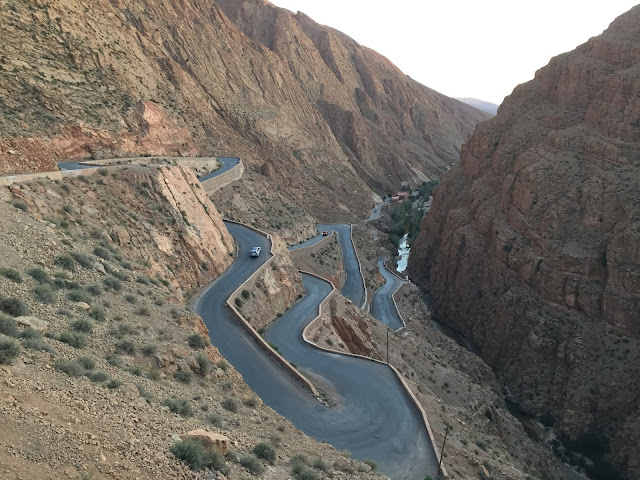"Go ahead, spend the damn money and take the damn trip, no sense being the richest corpse in the cemetery."
W.B. MacPhee
On November 23rd I turned 60, and I wanted to do something special for that milestone birthday, so we got out our world map and poured over the various countries that Melanie & I wanted to visit. We invited lots of friends to join us and in the end, my best friend Glynn Balsom, decided to come along for the latter half of the trip.
So on October 29, 2019 we headed for the north African country of.......
So on October 29, 2019 we headed for the north African country of.......
Morocco
Officially the Kingdom of Morocco, loosely translated it means 'the farthest land of the setting sun' or, more prosaically, the 'far West'. Morocco stands at the western extremity of the Arab and Muslim world. A land of rich variety, natural contrast and extraordinary mixed cultural heritage. Morocco spans an area of 710,850 km2 and has a population of over 36 million.
A lot of Morocco's charm lies in the labyrinths of the imperial cities of Marrakesh, Fes, Meknes and Rabat, however there are also the snow capped Atlas mountains and the eerie solitude of the desert. In contrast to this are the Atlantic & Mediterranean beaches that attract thousands of sun-seekers to the burgeoning resorts along both of these coasts.
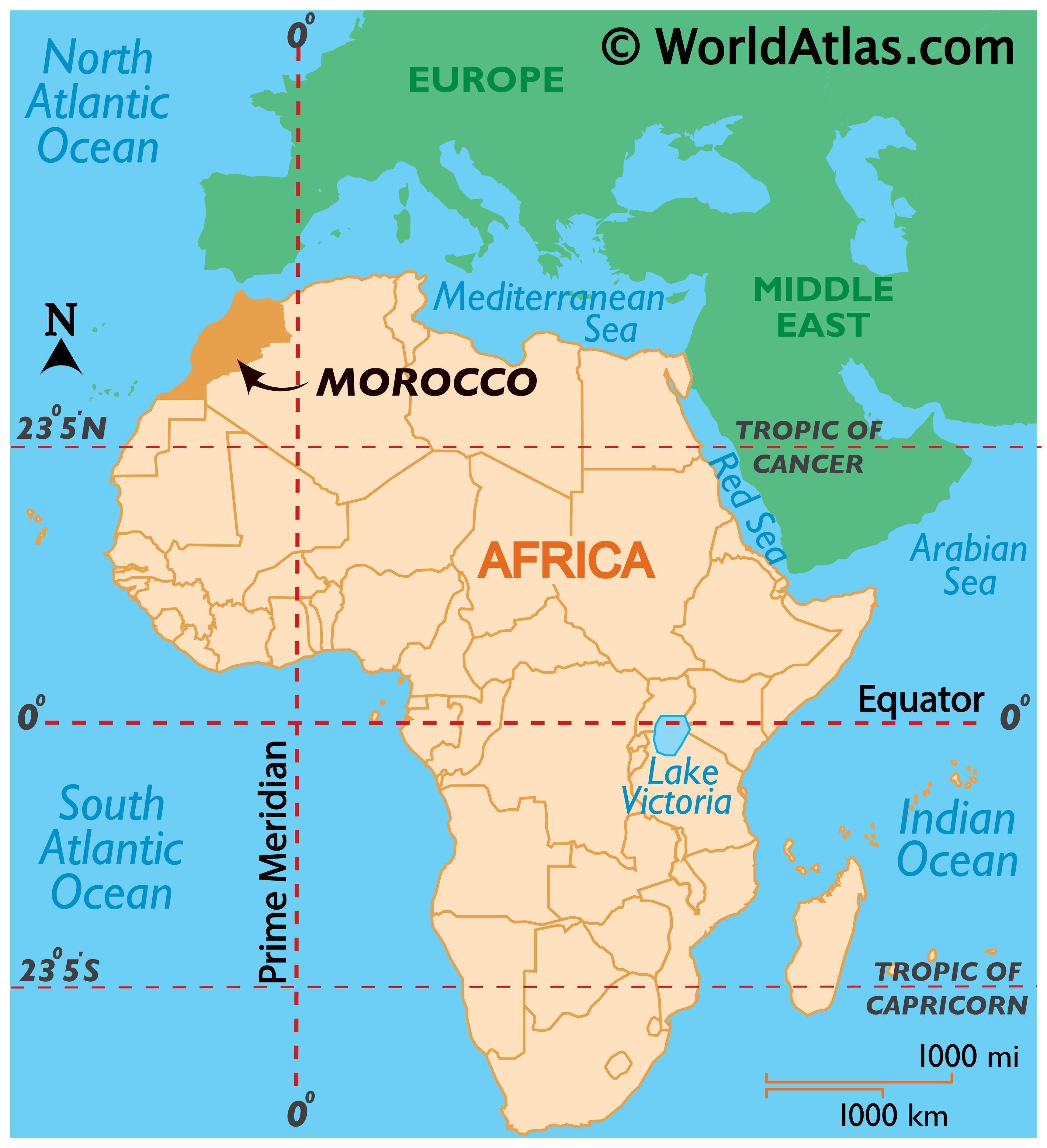
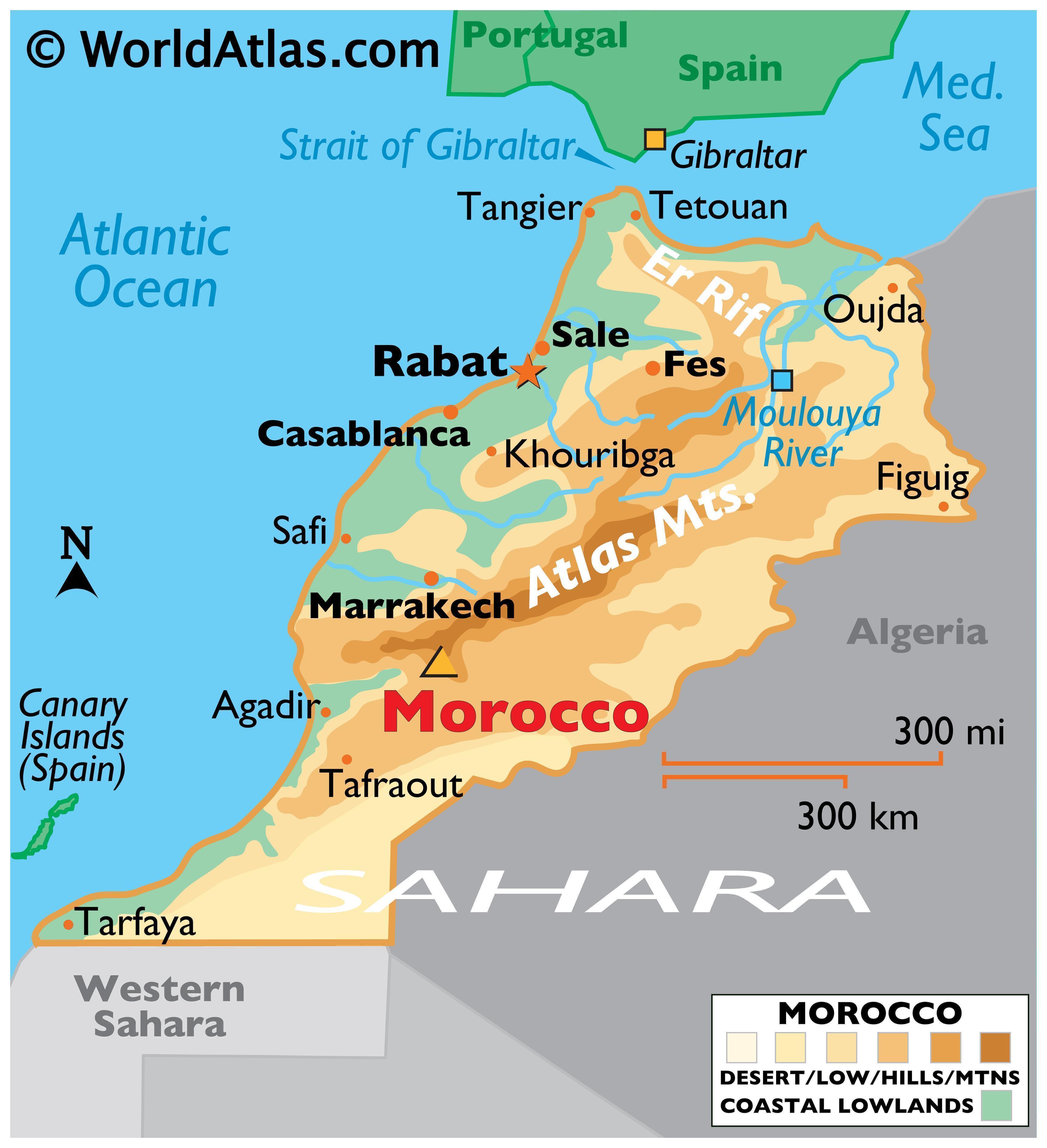
We fly into Casablanca and immediately take the train from the airport to the capital city of........
Rabat is on the Atlantic coast so we headed out of the Medina to have a look....like ya would!
Our walk about leads us to.......
A lot of Morocco's charm lies in the labyrinths of the imperial cities of Marrakesh, Fes, Meknes and Rabat, however there are also the snow capped Atlas mountains and the eerie solitude of the desert. In contrast to this are the Atlantic & Mediterranean beaches that attract thousands of sun-seekers to the burgeoning resorts along both of these coasts.


We fly into Casablanca and immediately take the train from the airport to the capital city of........
Rabat
Morocco’s political and administrative capital may be short on top-drawer tourist attractions, but it compensates with plenty of charm. The ville nouvelle's palm-lined boulevards are clean, well kept and relatively free of traffic. There's a clean central beach, an intact and evocative kasbah, and an attractive walled medina that is far less touristy than those in other large cities.
"Of all the gin joints in all the towns in all the world, she walks into mine."
Rick Blaine (AKA: Humphrey Bogart)
Movie: Casablanca
We arrive in Rabat and head to our hotel which is situated in the....
Medina
A 'medina' is the old part of a town or city, found in many countries of North Africa, not just Morocco. It is typically walled, and contains narrow streets, fountains, palaces and mosques. Many Medina's are car-free as there is not enough space in the alleyways for cars to pass.
 |
| The Medina is home to the 'souq' - the marketplace and commercial hub, where you can buy just about anything, except perhaps a vehicle, and that's because the streets are too narrow to get them here. |
 |
| Remember when I said you could buy just about anything? "Would that be a small turtle or large turtle for you today sir?" |
 |
| "Look B. No people! No vendors!" |
 |
| Here comes the fish-monger. |
 |
| We were staying in the Medina, so everynight we would go walking around taking in the sites and sounds (and there be a lot of them)! |
Rabat is on the Atlantic coast so we headed out of the Medina to have a look....like ya would!
 |
| Leaving the walled Medina. |
 |
| The selfie miesters with Rabat's 1920 Fort de la Calette Lighthouse to light our way. |
 |
| The lower reaches of the North Atlantic. 500 kms directly out from here are the Madeira Islands (see our blog on Madeira Islands). |
 |
| Rabat's beach. Not much action happening there except for a few surfer dudes. |
Right next to the beach, perched on a bluff, is the.....
Kasbah des Oudaias
Built by Muslim refugees from Spain in the 12th century, the historic citadel occupies the site of the original ribat (fortress-monastery) that gave the city its name. It is predominately residential with narrow alleyways that are lined with whitewashed & blue houses.
 |
| Getting ready to rock the kasbah. |
 |
| The selfie miesters on the Plateforme du Semaphore overlooking the beach. |
 |
| Another view of the Plateforme du Semaphore. |
 |
| The alleyways of the kasbah are a real treat to walk around with beautiful well-kept homes reminiscent of what the Greek Islands were like 40 years ago. |
 |
| No camera toting tourist, no vehicles, no carpet salesmen - just peace and quiet. Guess we won't be Rockin' the Kasbah afterall. |
 |
| Hey Melanie are you having fun yet? |
 |
| All that is missing is an outdoor pub selling ice cold beer. |
 |
| Looking back at the kasbah. |
Continuing on, we head for Rabat's most famous landmark, the.....
Tour Hassan
Originally part of an ambitious 12th century project to build the world's second-largest mosque (after Samarra in Iraq), unfortunately its patron, Sultan Yacoub al-Mansour, died before the building was complete and the construction was abandoned. The mosque was destroyed by an earthquake in 1755, and today only the tower and a forest of shattered pillars testifies to the grandiosity of al-Mansour’s plans.
 |
| The minaret was meant to reach a height of more than 60 metres but only made it to 44 metres before the old guy passed in the year 1199. |
 |
| Ceremonial mounted guardsmen still guard the place. |
 |
| I have to admit the mosque would have been massive if it had been completed. |
 |
| At the base of the tower is a massive fountain system. |
 |
| On the same site, is the Mausoleum of Mohammed V, the present king's father. Couldn't get in to have a gander, but alas, it's only a dead guy in the end! |
We went for a walk about....
 |
| Looking across the river at Rabat's sister city, Sale. |
 |
| Main street in the ville nouvelle, or the new city. Which means basically any part of the city outside of the Medina. |
Our walk about leads us to.......
Chellah
Beyond the city walls and enclosed within the necropolis of Chellah are the remains of the ancient Roman city of Sala Colonia. The Romans were here from the 1st century until the late 4th century AD.
 |
| Evidently this place must be on the tour bus circuit. |
 |
| In 1339 AD these imposing walls were built to enclose the necropolis. That's almost 700 years ago. A big WOW from me! |
 |
| This dynastic necropolis is the burial place of 4 generations of Sultans. Not of the Swing dynasty of Sultans they're buried someplace else. |
 | ||
| The remains of a mosque with its minaret topped by a stork's nest. |
 |
| A partial statute of Roman emperor, Biggus Dickus. |
 |
| The entire monumental centre of the city was organized around two large limestone paved streets. This is one of those streets. |
After 4 days in Rabat we head inland and north however we take a side trip to the imperial city of......
Our real reason for being in this part of Morocco was to visit the site of the largest and best preserved Roman ruins in the country......
We leave Volubilis and once more hit the road...
We arrive at our next destination, the oldest of the imperial cities.......
Like all Moroccan cities, there are two parts to the city; the old Medina and the ville nouvelle, which is within walking distance of our riad.....
After a few days of exploring Fez, we start a four day overland private tour to the Sahara desert and beyond......
Back on the road we stopped long enough to feed some beggars (or buggers depending on your point-of-view)....
We leave the mountain cold behind us (yes it was cold) and headed further south pass palm-fringed towns and oasis'.....
After a relatively long drive (approximately 10 hours) we arrive in Merzouga which offers nothing of interest to anyone except its close proximity to the Erg Chebbi, Morocco's only genuine Saharan erg - one of those huge, drifting expanses of sand dunes that typify the Sahara desert. From here we mount up and head into the Erg.....
The next day we get up and do it all over again arriving back in Merzouga in time to grab a quick shower before hitting the road for Day 2. We head to the Dades Gorge via Tamegroute before finalizing Day 2 at the Todra Gorge.
We arrive in Tamegroute, a village where the Islamic religious school is said to cure anxiety and high blood pressure, thanks to the post-mortem calming influence of embalmed Sidi Mohammed Ben Nassir – founder of the influential and learned Nassiri brotherhood. At least that's what the brochure states, so we checked it out....
We leave Tamegroute (all calm and everything) and continue our journey.....
Our final day sees us heading up the 'Route des Kasbahs' to the African "Holywood" city of Ouarzazate. The movie business gradually took off in Ouarzazate and ‘Ouallywood’ movie studios have built quite a resume providing convincingly exotic backdrops for movies supposedly set in Tibet, ancient Rome, Somalia and Egypt.
Sooner or later the Medina & in particular the Djemaa el-Fna becomes too much and you get that suffocation feeling happening. No worries, because Marrakesh comes with a very extensive inner city garden system....
We head to the train station to gather Glynn, who is a full 24 hours late (a big shout-out to Air Canada for doing everything possible to live up to their motto - 'we're not happy until you're not happy').
Glynn arrives just long enough to have his picture taken in Marrakesh before we have to catch a bus to.......
"We'll always have Paris."
After four days in Essaouira we once more hit the road, this time we head further south to the most non-Moroccan of cities......
Meknes
Considered by some as the Versailles of Morocco (although I hardly think it deserves that hyperbole), nevertheless, the city of 750,000 is the brainchild Sultan Moulay Ismail, the architect of Meknes’ glory days. Remnants of no less than three sets of fortifications, ingeniously incorporated into the city's road networks, make it clear how important this city once was. Meknes is surrounded by hinterland that provides abundant olive and wine crops.
 |
| Outside the gate to the Medina......always a gate! |
 |
| Place El Hedim, the local town square. The town squares are usually the home of the infamous Moroccan hustler and this town square was no different. |
 |
| Opposite of the Place El Hedim is yet another gate piercing the 25kms of walls surrounding Meknes.... |
 |
| ....and on the other side of that gate! |
 |
| Agdal Basin is an enormous stone-lined lake that's apparently 4 metres deep. It served as a 'pleasure lake' for the Sultan, although I'm not sure what a 'pleasure lake' for a Sultan would encompass. |
We make a brief stop at the tiny hillside community of......
Moulay Idriss
This tiny town is named after Morocco's most revered saint, a great-grandchild of the Prophet.
Moulay Idriss fled Mecca in the late 8th century AD in the face of persecution at the hands of the Caliphate, who was based in Baghdad. Once here in Morocco he was able to convert the locals to Islam and made himself their leader....like ya would!!
 |
| Looks like an attractive town from a distance, nestled in a cradle of verdant mountains, but closer up not so much. |
 |
| We wandered around the narrow alleyways for a bit but with no craft brewery to keep our attention we moved on. |
Volubilis
One of the Roman Empire's most remote outposts, Volubilis had direct Roman rule that lasted for 240 years starting in the 2nd century AD. Its most amazing features are the many beautiful mosaics preserved in situ, and it was declared a UNESCO World Heritage site in 1997.
 |
| Melanie approaching the judiciary Basilica which was the meeting place for the city leaders. |
 |
| The ruins of Volubilis remained intact until the mid-18th century, when they were largely destroyed by an earthquake. |
 |
| This street, called Decumanus Maximus, runs parallel to Water Street. |
 |
| Atta girl! |
 |
| Yes there are lakes here! |
 |
| Squash for supper. |
 |
| Row after row of olive tree orchids. |
Fez
In its heyday, Fez attracted scholars and philosophers, mathematicians and lawyers, astronomers and theologians. In fact, the oldest existing, and continually operating educational institution in the world is the University of Karueein, founded in 859 AD in Fez, Morocco. Craftsmen built houses and palaces, kings endowed mosques and medersas (religious schools), and merchants offered exotic wares from the silk roads and sub-Saharan trade routes.
 |
| The main square in old town Fez. During the daytime it is a quiet place to relax and people watch...... |
 |
| ....during the night, the square comes alive, an even better place to relax and people watch. |
 |
| Will ya look at that.....another gate! This one leads into the world’s largest car-free urban area: The Fez Medina, also known as the Fes el-Bali. |
 |
| Coppersmiths at work pounding copper and brass to make a wide variety of utensils and tools for local consumption. These are NOT tourist-staged operations......trust me on that one! |
 |
| The local pharmacist will whip up just about any concoction required to cure what ails you, from recipes passed down through the centuries. |
 |
| Somewhere out there is a headless camel running around. |
 |
| The Fez River flows right through the Medina and leads directly to the #1 tourist attraction in the old-town, the Chouara Tannery....... |
 |
| .....we know we are getting close to the tannery because the scraped and cleaned wool from sheep hides are being dried along the concrete banks of the river. |
 |
| You used to be able to walk down among the workers, but the Chinese tourists kept falling into the solution, so they had to put a stop to it. True story! |
 |
| Alibaba. |
 |
| The only source to move large goods within the Medina. |
Like all Moroccan cities, there are two parts to the city; the old Medina and the ville nouvelle, which is within walking distance of our riad.....
 |
| The chic wide-avenues provide a jarring contrast to the old Medina - a modern flipside to the ancient city. |
 |
| Tree lined and modern avenues, you could just about be forgiven for thinking you're in a southern French city. |
 |
| Sipping cold mini-beers, munching on olives and people watching along the cafe-lined main street of the ville nouvelle. Like ya would!! |
Roadtrip
We leave Fez early and drive through the Ziz Valley to the Swiss inspired mountain village of Ifrane before continuing onwards to the desert village of Merzouga. We mount up on camels at Merzouga for a two hour ride into the desert where we spend the night.
"… It's still the same old story
A fight for love and glory."
Lyrics sung by Sam (AKA: Dooly Wilson)
Movie: Casablanca
We stop for breakfast in Ifrane......
 |
| Here in Ifrane you would be hard-pressed not to do a double-take and wonder whether you hadn't just left Morocco and dropped into Switzerland...... |
 |
| Ok I got the alpine look, but the rock lion left me a little baffled. |
 |
| This fella was a bargain, he only demanded 10dh$ to allow us to take his picture. |
We leave the mountain cold behind us (yes it was cold) and headed further south pass palm-fringed towns and oasis'.....
 |
| We pass over/through the Ziz Gorge and enter another world..... |
 |
| The only patches of green are the oasis', such as this rich valley of palm trees. The small town below is aptly called 'Rich'. |
 |
| A two hour camel ride awaits us. |
 |
| Typical of many deserts, this one is blazing hot in the daytime and super cool in the nighttime. |
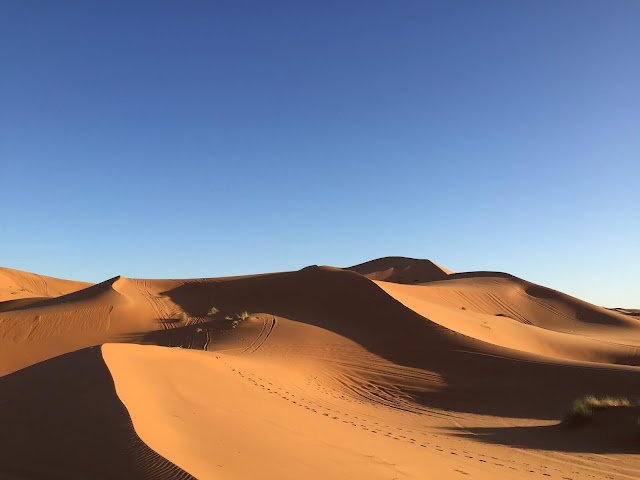 |
| These dunes are huge, ranging in height up to 150 metres and stretching for 28 kms. |
 |
| The stillness is only broken by passing 4X4's, dune buggies and the constant farting of the camels. Jeeze boys what are you eating? |
 |
| Unionized camels taking their 15 minute break. |
 |
| Still crazy after all these years. |
 |
| "OH YEAH. Scratch right there......... |
 |
| .....dat's wat I'm talking bout." |
 |
| We stop for a view of the setting sun. |
 |
| After two hours we arrive at our camp. There are perhaps a dozen such camps out here and each can accommodate about 50 people. |
 |
| Now these are not typical tented camps but rather something akin to the lap of luxury. |
 |
| Turns out we are the only tourist in residence tonight. |
 |
| We are only 3 kms from the Algerian border and some of these caravans are headed there. |
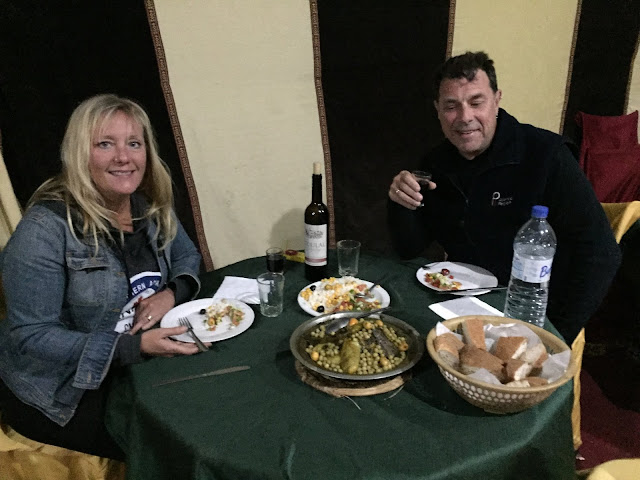 |
| I think they were expecting 50 people and cooked enough food for that amount of people. |
 |
| Mutt and Jeff break out in song. They had a captive audience!!! |
"Round up the usual suspects."
Captain Renault (AKA: Claude Reins)
Movie: Casablanca
 |
| I had set a snare while in the desert and caught this guy, a Desert Fox. My what big ears you have! |
 |
| While in Merzouga we stopped at a Berber house to see Sgt Pepper's Lonely Hearts Club Band. |
 |
| This mosque and attached school apparently houses a library dating back to the 11th century with thousands of Islamic manuscripts and it is considered one of the best in the world. Who knew? |
 |
| Samii & moi getting ready to have our anxiety and high blood pressure calmed! |
 |
| A glimpse inside of a mosque. Where are all the pews? |
 |
| The real way to calm anxiety and high blood pressure. Spices at the local spice market next door. |
 |
| Moose crossing. |
We arrive at our next stop, the Boumalne Du Dades for lunch and the like, before heading into the Dades Gorge......
 |
| Imagine what a can of paint could do to the mud village behind us! |
 |
| No trip to this part of the world is complete without the carpet salesman and his magic carpet ride hard sales pitch. |
 |
| The Dades Gorge. Impressive, but we only stayed for a few minutes as the hour was getting late. |
Our final destination for the night was the equally impressive Todra Gorge, some 300 metres high but only 10 metres wide at its narrowest point.
 |
| .....to sit around the wood stove and have some sheesha with the locals. |
"You know what I want to hear, you played it for her you can play it for me."
Rick Blaine (AKA: Humphrey Bogart)
Movie: Casablanca
 |
| Many of the famous Holywood studios have set up shop in Ouarzazate, with over 20 films being filmed here and in neighbouring Ait Ben Hoddou. |
 |
| All fake, except Melanie, she's real. |
 |
| King B sitting on the Aladdin 2 film set. |
We leave the fake stuff behind and head for the real stuff of Ait Ben Hoddou. With the help of some Hollywood touch-ups, this UNESCO-protected red mudbrick ksar (fortified village) seems frozen in time, still resembling its caravan days from the 11th century. Movie buffs may recognise it from such movies (to name a few) as Lawrence of Arabia, Jesus of Nazareth, Jewel of the Nile, Gladiator and most recently, Game of Thrones.
 |
| The above picture is a scene taken from Game of Thrones. Game of Thrones built a fake gate and used a painted hillside backdrop for its filming here. |
 |
| The real stars! |
 |
| .....the outline of the gladiator ring can still be seen at the base of the ksar. |
 |
| Move over Russell Crowe, the real gladiators are here! Samii said "shit"....... |
 |
| ......B said "piss"...... |
 |
| .....and the fight was on! |
 |
| We climbed to the top for a look about. |
 |
| We had a window of opportunity for this picture before some tourist would walk by. |
 |
| Where are those damn dragons? |
Day 4 brings us to the city of........
Marrakesh
There can be few people who have not heard of Marrakesh. During the 60's & 70's it was a magnet for travellers, along with other cities such as Istanbul, Kabul, Zanzibar and Kathmandu. The hippies have since been replaced by hordes of package tourist with more money and considerably less time than their more laid-back predecessors.
Sitting against the backdrop of Morocco's highest mountains, Marrakesh is the country's second largest city with a population of 1.5 million.
“Here’s looking at you, kid.”
Rick Blaine (AKA: Humphrey Bogart)
Movie: Casablanca
 |
| Our friend, Glynn, was to meet up with us in Marrakesh, so we decided it was best to stay in a hotel in the ville nouvelle section of the city as opposed to a riad within the Medina. |
 |
| Need a lift? These guys pry the ville nouvelle hoping to whisk you away for a city tour, but seriously, it is all very walkable. |
 |
| The main artery into the mazy muddled Medina is the vast square of Djemaa El Fna and although it's a lively place at any time of day, it comes into its own in the evening. |
 |
| We dived right in to the Medina but soon tired of the constant hustle. NO, I DO NOT WANT TO BUY A CARPET. |
 |
| The main focal point of most of the buildings within the Medina are the elaborate carved doors. |
 |
| A guimbri player. This bass sounding 3 string instrument can be seen just about everywhere in Morocco. |
 |
| Water sellers waiting to pounce on the first unsuspecting tourist that feels compelled to take a picture of them. That picture will cost you 200dh$. |
Sooner or later the Medina & in particular the Djemaa el-Fna becomes too much and you get that suffocation feeling happening. No worries, because Marrakesh comes with a very extensive inner city garden system....
 |
| A welcome and tranquil refuge from the hustle and bustle of the Medina. |
 |
| The Koutoubia mosque is the tallest (70 metres) and most famous landmark in Marrakesh, visible for kilometres in any direction. |
 |
| Jardin Menara was built in the 1800's and was once the exclusive preserve of sultans and high-ministers. |
 |
| I think they got that angle covered! |
 |
| Recycle the bicycle. |
 |
| The Marrakesh train station. Immortalized by the folk group Crosby, Stills and Nash in the song Marrakesh Express. |
 |
| Glynn just outside the train station. |
Essaouira
Known as the ‘Windy City of Africa’, the wind blows so hard here that relaxing on the beach is near impossible, this means that the town is bypassed by the hordes of beach tourists who descend on other Atlantic Coast destinations. The majority of visitors that come here are independent travellers (as opposed to the package tourist) who wander through the spice-scented lanes of the fortified Medina in search of some of the best restaurants in the country.
"We'll always have Paris."
Rick Blaine (AKA: Humphrey Bogart)
Movie: Casablanca
 |
| The only point of land stopping the wind and waves in Essaouira is Florida. |
 |
| Like other Moroccan city Medinas, this one is chock-a-block full of narrow alleyways and passages crammed to the gunnel's with goods to sell..... |
 | ||
| We have another buddy, I won't mention Art's name, that likes to buy purses when travelling. |
 |
| Right next door to our Riad is a tiny coffeeshop that includes the ever present cat. |
 |
| Essaouira's Medina is a buffet of colours. |
 |
| OK I have to ask......who comes to Morocco to buy a carpet????. |
 |
| Tombouctou....not to be confused with Timbouctou. |
 |
| Bombs away dream baby. |
 |
| The defense mechanism. |
 |
| The Portuguese maintained a fort here since 1506. Long time!! |
 |
| The real charm of Essaouira, in my mind, is the port which is jam-packed with blue sardine fishing boats which catch that tasty tiny fishy morsel. |
 |
| The entire old city, including the port, has been designated as a UNESCO World-Heritage site. |
 |
| Around every corner is a Kodachrome moment. Mama don't take my Kodachrome away. |
 |
| The main gate leading from the port to the main square. |
 |
| Essaouira's Medina main square, a somewhat subdue place when compared to the other Medina main squares. |
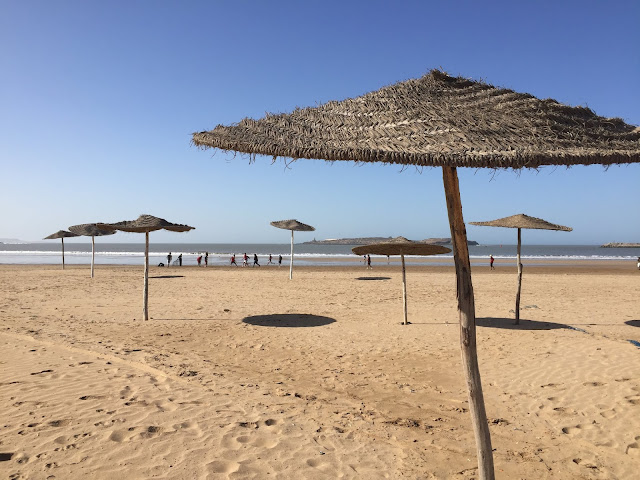 |
| Essaouira's largely deserted beach stretches for 10kms. |
 |
| Beginning in the late 1960s, Essaouira became something of a hippie hangout, with its claim to fame being a favoured city of the late Jimi Hendrix. Look at Glynn walking in Jimi's footsteps!! |
After four days in Essaouira we once more hit the road, this time we head further south to the most non-Moroccan of cities......
Agadir
The city was completely rebuilt following a devastating earthquake in 1960 and is now the country’s premier destination for sun, sand, pubs and pizza. Laid out as a large grid of downtown streets, surrounded by spacious residential suburbs, the city hits its stride on the beachfront promenade, where Moroccan street life comes with a refreshing sense of space. Arching south of the shiny white marina, the sandy beach offers clean water and 300 sunny days a year. Agadir caters mainly to package-tour holidaymakers which leads you to ask why we came here? Well after 20+ days of bumming around the country we came for some R-n-R and to celebrate my 60th birthday.
"Play it Sam, play As Time Goes By"
Ilsa Lund (AKA: Ingrid Bergman)
Movie: Casablanca
 |
| Our hotel in Agadir for the next 10 days. Breakfast included for $54 Cdn per day......not to shabby! |
 |
| The hotel had beautiful well maintained gardens.....not to shabby! |
 |
| The hotel had awesome guests.....not to shabby! |
 |
| Met awesome people at the hotel, such as (L - R) Moroccan Girl, Teddy the Finlander, Fatima the Sweetie, and the rest of us! |
 |
| We were minutes from an awesome restaurant where Glynn was treated like a "Rock Star". |
 |
| Things that make you go 'Hmmmm?'. |
 |
| The restaurant had live music every night. Hey weren't these the same guys we saw in Act 4 Scene 2 (Merzouga)? |
 |
| The large beachside promenade (minutes from our hotel) stretches for kilometres...... |
 |
| ......the large sandy beach (minutes from our hotel) stretches for kilometres. |
 |
| Where all the people go? |
 |
| Night-time stroll on the promenade. The lite Arabic sandscript in the distance hill states: "God, King, Country". |
As I said earlier we came here to Agadir specifically to celebrate the 60 years I've stumbled around on this planet....
 |
| Glynn getting 'primed up' for the BIG night! |
 |
| We brought a party with us: (L - R): Linda, B - the Man of the Hour, Melanie, Gudrun & Fatima. Glynn was off signing autographs. |
 |
| Sixty never looked so good! |
 |
| Glynn, the Rock Star, just told the ladies that they can be his back-up singers for his rendition of Happy Birthday.... |
 |
| .....practicing for the great singing rendition of Happy Birthday. |
 |
| And at 6:05PM sixty years ago Big B came bouncing into the world.....all 9 lbs and 7 ozs of me! |
 |
| Look at me now......all growed up and mature-like! |
I survived the best 60th birthday I've ever had! Look out 70!!!
We spend another couple of days in Agadir before heading back to Casablanca to fly home.....
 |
| Setting sun on Agadir beach! Awesome country! |
A special note for all: You may have noticed that I used a lot of quotes in this blog from the 1942 movie, Casablanca, but I did not use the most famous line ever associated with that movie: "Play it again Sam". I didn't use it because it was never said in the movie. It is one of the most widely misquoted film lines, but I like it, so.....
Play it again Sam





























